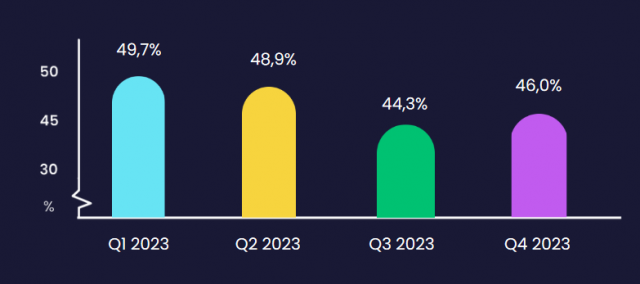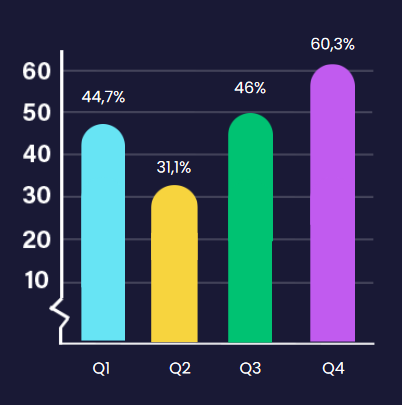
It is a notable outlier in the new Sourcing Benchmark , with which Cooble specialists map developments in the world of sourcing every quarter. On the one hand, there is a decline in the percentage of candidates who are presented to the client following a call appointment, which apparently results in better conversations. Or, at least: more speed. At least: not only are more and more referred candidates being invited for a second interview, but no less than 60% also immediately received an offer in that second interview, more than ever.
“That 60.3% is the highest percentage since we wrote the benchmarks,” says Milou Verhoeks, owner of Cooble together with Jan Karel Sindorff. ‘This percentage has increased considerably. We increasingly see that after a positive first interview, candidates are prepared for an offer in the second interview. A third of the candidates who did not receive an offer withdrew from the procedure, 2 in 3 were rejected.’
Busy December
According to her, the figures for the last quarter of last year mainly show the busy month of December. ‘As a result, many conversations are scheduled in January. Just like in 2022, we will therefore also see a decrease in the number of candidates for their first interview in the last quarter in 2023.’ Of the proposed candidates, 40% were ultimately invited for an initial interview. “This number is relatively low and there are several possible causes,” says Verhoeks. ‘For example, some vacancies have been put on hold , better candidates were now in the procedure or the candidate did not sufficiently meet the requirements.’
Short lines ensure that you introduce the right candidates to the vacancy holder.’

According to her, it is a percentage that is strongly related to ‘communication with the vacancy holder. Short lines ensure that you propose the right candidates and, as a sourcer, you know in time when the vacancy is no longer active.’ After an initial interview, almost half of the candidates (47%) are invited for a second interview, according to the latest figures. “This is a lot more than in the previous quarter, when it was just over 40%,” says Verhoeks. Of those who did not receive a second interview, 40% withdrew themselves, 60% were rejected by the client.
More in the talent pool
As a general trend, Cooble sees a decrease in the number of candidates we propose following a telephone appointment. We can therefore cautiously conclude that we not only speak to fewer people, but that these people also lose weight more often. At 48.5%, we presented less than 50% of the spoken candidates to our clients for the first time last quarter. About 2 in 3 candidates who do not proceed are rejected by us because they do not sufficiently match the vacancy requirements. A third withdraw after receiving more information about the vacancy and organization.’
‘The number of candidates we propose as a result of a telephone appointment is decreasing.’
What is striking: no less than 17.9% of the candidates are added to a talent pool after an introduction. “These candidates are not yet ready for a transfer, but may be the right talent in the (medium) long term,” says Verhoeks. The data in the benchmark relates to the work of 43 sourcers for 65 organizations and 316 vacancies. In total, Cooble sent out more than 16,000 messages in the last quarter of 2023. It subsequently received more than 7,700 responses.
Sourcing pressure is increasing
Verhoeks says he has noticed that the ‘sourcing pressure’ is increasing: many potential candidates are often approached. She says she is very satisfied with the overall response rate of 46% – slightly higher than the response rate of 44.3% in quarter 3. ‘The fourth quarter is often a more difficult quarter. During the holidays people are less inclined to respond, so you often see a catch-up in quarter 1. What helped us enormously in quarter 4 was sending out the third reminder. It is important to still keep this personal and not to come across as too pushy.’

The tight labor market means that ‘you have to act quickly if someone shows interest’, says Verhoeks. ‘For example, candidates often lose interest if it takes too long to schedule a telephone appointment or if it proves difficult to find a suitable time when both parties are available. Moreover, in a tight labor market, the talent pool is becoming increasingly important. Is someone not a match at the moment? Then that person could be interesting for the future. We see that we are able to fill vacancies more quickly at some customers by building up talent pools.’
Know everything?
Download the entire benchmark here :


